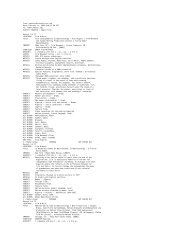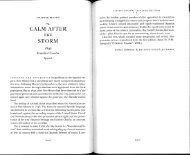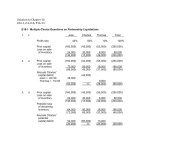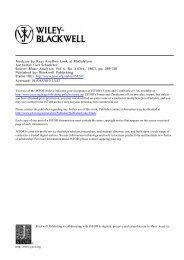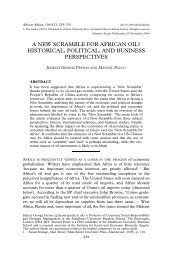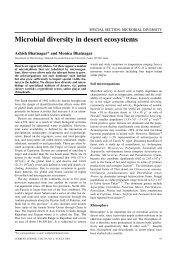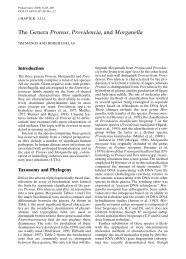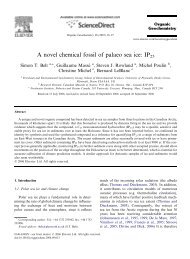The Genus Serratia
The Genus Serratia
The Genus Serratia
Create successful ePaper yourself
Turn your PDF publications into a flip-book with our unique Google optimized e-Paper software.
224 F. Grimont and P.A.D. Grimont CHAPTER 3.3.11<br />
was isolated in fecal samples from seven sparrows<br />
and unidentified birds. <strong>The</strong> study involved<br />
90 wild European birds (Müller et al., 1986).<br />
About 40% of trapped wild rodents and<br />
shrews carried <strong>Serratia</strong> strains in their gut without<br />
any visible sign of infection upon autopsy.<br />
<strong>The</strong> following animal species were found to carry<br />
<strong>Serratia</strong> spp.: 75/180, Apodemus sylvaticus; 7/23,<br />
Microtus arvalis; 3/11, Clethrionomys glareolus;<br />
1 /2, Micromys minutus; (rodents); 7/9, Sorex; and<br />
1 /3, Crocidura (shrews) (P. Giraud, F. Grimont,<br />
P.A.D. Grimont, unpublished observations). <strong>The</strong><br />
S. liquefaciens complex (S. liquefaciens, S. proteamaculans<br />
and S. grimesii) represented 73 to<br />
94% of all <strong>Serratia</strong> isolated from the gut of small<br />
mammals and from the soil and plants around<br />
traps (Table 1).<br />
<strong>Serratia</strong> in Humans<br />
<strong>The</strong> healthy human being does not often become<br />
infected by <strong>Serratia</strong>, whereas the hospitalized<br />
patient is frequently colonized or infected. At<br />
present, S. marcescens is the only known nosocomial<br />
species of <strong>Serratia</strong> (Table 1). S. liquefaciens<br />
and S. rubidaea are occasionally isolated from<br />
clinical specimens, but their pathogenic role is<br />
not established. <strong>The</strong> isolation of other <strong>Serratia</strong><br />
species is anecdotal (Farmer et al., 1985; Gill et<br />
al., 1981).<br />
Clinically, <strong>Serratia</strong> infections do not differ<br />
from infections by other opportunistic pathogens<br />
(von Graevenitz, 1977): respiratory tract infection<br />
and colonization of intubated patients (e.g.,<br />
Cabrera, 1969; von Graevenitz, 1980); urinary<br />
tract infection and colonization of patients with<br />
indwelling catheters (e.g., Maki et al., 1973); surgical<br />
wound infection or superinfection (e.g.,<br />
Cabrera, 1969); and septicemia in patients with<br />
intravenous catheterization or complicating a<br />
local infection (osteomyelitis, ocular or skin<br />
infections) (e.g., Altemeier et al., 1969). Meningitis,<br />
brain abscesses, and intraabdominal infections<br />
are more exceptional.<br />
<strong>The</strong> relationship between a <strong>Serratia</strong> strain and<br />
a patient may be in the form of an ephemeral<br />
association (in gut or throat, on hands or skin),<br />
a long-term colonization (in gut or urinary tract<br />
or on the skin), or a localized or generalized<br />
infection. <strong>The</strong> form of relationship might depend<br />
on the species or strain of <strong>Serratia</strong>, the entry<br />
route (ingestion, injection, catheter), an ecologic<br />
advantage (antibiotic treatment), or the patient’s<br />
physiologic status. Patient factors have been<br />
reviewed by von Graevenitz (1977). <strong>The</strong> localization<br />
of a hospital-acquired infection is often<br />
determined by the kind of instrumentation or<br />
intervention done (i.e., the entry route). <strong>The</strong><br />
same strain may cause a urinary infection in a<br />
urology ward, a bronchial colonization in an<br />
intensive care unit, and a wound infection in a<br />
surgery unit. Five epidemiological situation models<br />
can be described (adapted from Farmer et al.,<br />
1976):<br />
Model 1: “Endogenous,” nonepidemic infections.<br />
Sporadic cases of infection are observed<br />
that are associated with different <strong>Serratia</strong> strains.<br />
<strong>The</strong> strains are often susceptible to several antibiotics.<br />
<strong>The</strong> presence of a <strong>Serratia</strong> strain in feces<br />
is not a sufficient proof of the endogenous origin<br />
of the infection (<strong>Serratia</strong> are probably ingested<br />
daily with food). <strong>The</strong>re is no prevention mechanism<br />
in this epidemiological model.<br />
Model 2: Common source epidemics. A single<br />
strain (species, biotype, serotype) is found to<br />
colonize or infect several patients. Any type of<br />
<strong>Serratia</strong> can be involved, including pigmented<br />
biotypes of S. marcescens or environmental species<br />
(e.g., S. liquefaciens, S. grimesii, S. rubidaea).<br />
<strong>The</strong> strain is often susceptible to several antibiotics.<br />
An investigation can reveal a common<br />
infection source such as a breathing machine<br />
(the nebulizer and tubings should be sampled),<br />
a batch of perfusion or irrigation fluid, or an<br />
antiseptic solution. Identification of the source<br />
usually allows efficient control of the epidemic.<br />
Model 3: Patient-to-patient spread. <strong>The</strong> <strong>Serratia</strong><br />
strain involved is typically a multiresistant<br />
member of a nonpigmented biogroup of S.<br />
marcescens (biogroups A3, A4, A5/8, or TCT).<br />
No common source is found although several<br />
secondary sources are possible (sink or sponge<br />
in patients’ rooms, high rate of fecal carriage).<br />
Disinfection of inanimate sources often has no<br />
effect on the endemic state. In fact, the reservoir<br />
is usually the infected patient, and spread<br />
among patients occurs by transient carriage on<br />
the hands of nursing or medical staff. Handling<br />
of urinary catheters, wound drains, or tracheal<br />
tubes of infected (or colonized) patients contaminates<br />
the hands of personnel (Maki et al.,<br />
1973; Traub, 1972b). Hasty hand washing in an<br />
overbusy ward or in the course of an emergency<br />
(for example, (in an intensive care unit) allows<br />
the transmission of the strain to uninfected<br />
patients. <strong>The</strong>se patients are often immunocompromised,<br />
treated preventively with broad<br />
spectrum antibiotics and subjected to diverse<br />
instrumentation. <strong>The</strong> situation is typically<br />
endemic with epidemic peaks in periods of time<br />
when the ward is crowded. Transfer of infected<br />
or colonized patients from one ward to another<br />
or from one hospital to another often results in<br />
the spread of the outbreak to other wards or<br />
hospitals. Prevention of this epidemiological<br />
model is difficult (and in some countries, hopeless).<br />
Proper handwashing should be enforced.<br />
Some proposed solutions deal with ward/hospital<br />
management (e.g., smaller wards, higher<br />
nurse/patient ratio, separation of infected from



